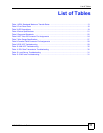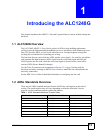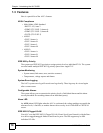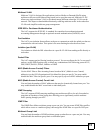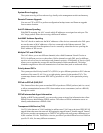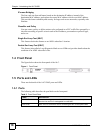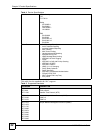
Chapter 1 Introducing the ALC1248G
ALC1248G User’s Guide
16
Discarding of IGMP Query Messages
The ALC discards IGMP query messages received from subscriber ports. This prevents
subscribers from hosting IGMP multicast servers.
IGMP Statistics
The ALC records the number of active users in an IGMP multicast channel (multicast group).
The ALC also records IGMP message statistics on a per port basis to ease management and
troubleshooting.
IGMP Message Rate Limiting
The ALC can limit how many IGMP message packets a subscriber can send per second. This
prevents subscribers from flooding the multicast server.
DLS Bonding (G.bond)
Bond two DSL ports for higher throughput. Packets can still pass through a single line if one
of the links goes down.
Static Multicast
Use static multicast to allow incoming frames based on multicast MAC address(es) that you
specify. This feature can be used in conjunction with IGMP snooping to allow multicast MAC
address(es) that are not learned by IGMP snooping. You can use static multicast to pass
routing protocols, such as RIP and OSPF.
Multicast Bandwidth Control
The ALC supports static bandwidth control for multicast traffic. Bandwidth limits can be
assigned to multicast channels. During IGMP snooping, the system checks the total bandwidth
usage to see if it exceeds the specified limit. If the specified limits are reached, the system
restricts the joining of multicast groups.
DHCP Relay
DHCP (Dynamic Host Configuration Protocol RFC 2131 and RFC 2132) allows individual
computers to obtain TCP/IP configuration at start-up from a server. You can configure the
system as a DHCP relay agent to have another DHCP server provide TCP/IP configuration for
the clients. In addition, you can set the system to forward client DHCP requests to specific
DHCP servers based on the VLAN ID. You can also specify up to two DHCP servers for each
VLAN to provide failover protection.
DHCP Relay Option82
The system supports DHCP relay agent82 (RFC 3046) that adds additional information to
client DHCP requests that the MSC relays to a DHCP server. It also supports adding the sub-
option 2 (Remote ID) with additional information.
DHCP Snooping
DHCP snooping allows the system to identify packets with DHCP server assigned IP
address(es) and block access of devices using unknown IP addresses on a subscriber port. You
can also manually add static IP addresses to the DHCP snooping table.






